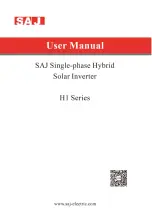
10
4. Installation and Operation
4.1 Installation
4.1.1 Environment
The Inverter/Charger must be installed in a protected location that is isolated from sources of high temperature and moisture.
To promote peak performance, battery cables should be kept as short as possible. However, do not install the Inverter/Charger
in the same compartment as non-sealed batteries. Accumulated hydrogen and oxygen generated by the batteries could be
ignited by an arc (resulting from connection of the battery cables) or by switching a relay.
The Inverter/Charger requires unrestricted air flow to operate at high power for sustained periods. Do not mount the inverter
in an enclosed space. This will restrict air flow and cause the inverter’s protection circuitry will activate, reducing maximum
available power.
4.1.2 System Grounding
Proper grounding is essential to assure safe operation of the Inverter/Charger. Grounding requirements vary in country and
application. For specific requirements pertaining to your location and application, consult local codes and the NEC.
4.2 Installation Diagrams and Charts
4.2.1 Terminal Block (AC Side)
4.2.2 Terminal (DC Side)
4. Installation and Operation










































